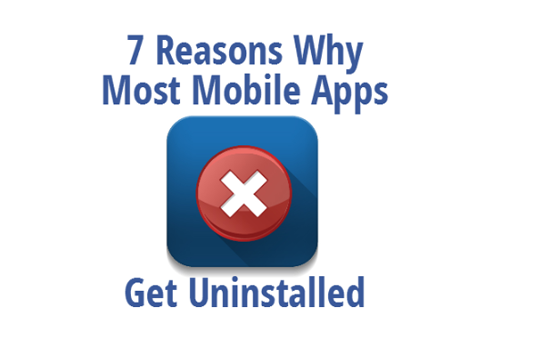7 Reasons Why Most Mobile Apps Gets Uninstalled

A whopping 26 percent of apps are only used for one time and then they are uninstalled by the user. This statistics is an indication why so many apps fail to make a mark or to put it otherwise, why a handful of apps enjoy such popularity and growth. There are many factors why users download an app. Great concept, unique feature set, smart look and feel and smooth user interface are among these reasons.
Once downloaded, however, a majority of these apps just lose their users' favor. Mainly because they just cannot deliver on the expectations created when users decide to download them. Doing great marketing on all fronts and offering a gamut of features are perfectly OK as long as you can deliver up to the expectations of users. Here we would introduce seven common reasons that make most mobile apps get uninstalled.

1. Forcing users to social login
Initially, a login procedure with a social account tie-in was largely viewed as the simple alternative to get past the complication of going through a registration process. Recently, however, social logins are increasingly used by apps for getting access to personal information. App makers are aware of the advantage of getting personal information while users log in with social account. But this proves to be threatening for the users as far as data security is concerned. Secondly some apps that keep themselves available as 'free' on the app store force users to share 'Likes' on social pages. Facebook, however, has recently limited this practice. But all these combined make a depreciating user experience that helps a user make up his or her mind to uninstall the app.
2. Threatening privacy
You can continue wondering, why some simple utility or gaming apps like to access data in your handset phonebook or other crucial personal information. That is a breach of trust and a sheer act of interference on the part of the app developer. As a user you have no other option but to quickly uninstall the app to stay clear of such snipping threats to your privacy and your private data. A mailing app will ask you to import contacts from other mail accounts and that is quite understandable. But when a music app asks you to do so, you not only have doubt but decide to quit the app altogether.
3. Ads that force people to watch
Forcing users to watch ad videos is already punished by the search engines and the time is ripe for some apps who indulge in this depreciating practice to stop. Even though these apps are offered mostly free (to sustain with the 'free' model they make such rigorous ads), most users just do not prefer to stand such nuisance and naturally it results in a straight uninstall. Sometimes they are just kicked out even without just going to the app homepage.
4. Bad UI and UX
Ultimately an app is sold and acclaimed on the merit of its concept, user interface and user experience. These three make up the gold standard for any successful app. Naturally, any app depreciating on its reviews because of bad UX or a bad UI will find its fate among the ones that are uninstalled following a single use. Often it has been seen that simple apps with clear navigation buttons enjoy better user appreciation and popularity than apps that in spite of a so-called smart look and feel cannot prove to be useful. Prominence in font, color and icons and readability makes the bare minimum standard for a good app design. Lacking these simple aspects many apps just lose user favor as soon as they are downloaded.
5. App does not work or load properly
There are thousands of apps that instead of being truly optimized on every front, just fail to load quickly or take too much time to navigate between pages. There are apps that crash too frequently and end up sending error messages. To make this depreciating experience even more frustrating there are apps that need to restart every now and then just to keep using it. All these are just enough to make a user decide to uninstall it. Another important negative aspect that remains relatively less known is that some apps make more use of device memory and consequently slow down a device quickly. Simple apps with minimum feature set even can garner a moderate success and popularity if they just load and navigate quickly and seamlessly. Without optimizing the app technically for a quick loading time you do not stand much chance.
6. Complicated registration process
A recent statistic revealed that a whopping 68 percent of users press the delete button just because of a cumbersome and complicated registration procedure that takes too much time to complete. Understandably a majority of these uninstalling actions are instant, just within seconds of downloading the app. There is nothing so grave and disastrous to pose threats to your app's reputation than being uninstalled for complicated registration. Nobody would like to download an app that makes them waste so much of time just to enter their information. Mostly, poorly designed apps offer such hurdles to the users.
7. Annoying users with too-many notifications
The majority of users do not like to check those tiny notification boxes and when there are too many to distract them, users may decide to uninstall the app. If your notification is kept at minimum level and rendered only when it is absolutely necessary for the user, it does not cause a stir. In-app purchase notifications are known for their selling potential, especially if your app is run in a 'freemium' mode ('free' and 'premium') or other app from the same developer. But these notifications should be used once or twice in the entire time a user keeps using your app. Too many notifications prompt users leave the app.
In short, to keep users loyal to your app, you have no alternative but tp perform up to their expectations and that includes eliminating these seven reasons that most mobile apps get uninstalled.
Ketan Parmar is a technical content writer and is working for a reputable iPhone Application Development Company - Yudiz Solutions. He gives the best suggestions for those who are seeking forward a skilled iOS App Developer and finding ways to create awesome reusable components for mobile environment.
Subscribe to Our Newsletter!
Latest in Software








